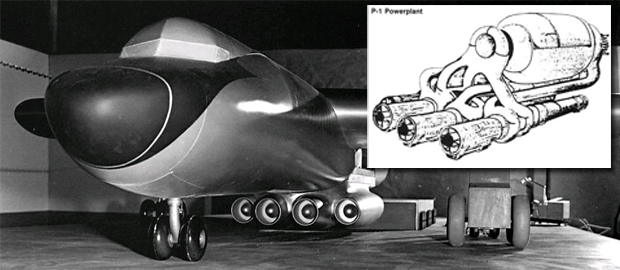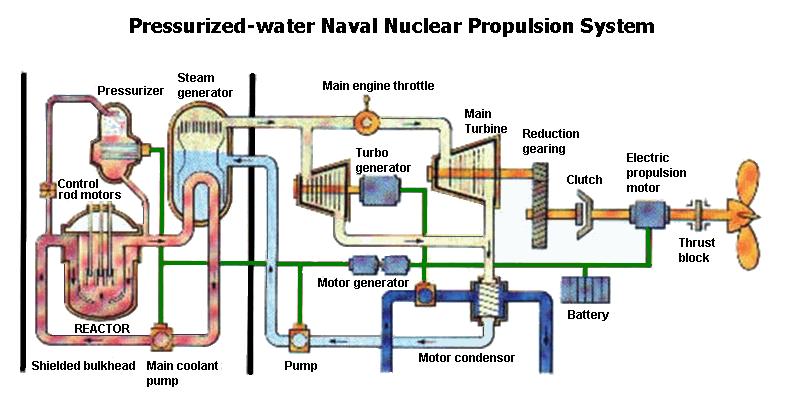Naval reactors undergo repeated power changes for ship maneuvering, unlike civilian counterparts which operate at steady state. Nuclear safety, radiation, shock, quieting, and operating performance requirements in addition to operation in close proximity to the crew dictate exceptionally high standards for component manufacturing and quality assurance. The internals of a Naval reactor remain inaccessible for inspection or replacement throughout a long core life -- unlike a typical commercial nuclear reactor, which is opened for refueling roughly every eighteen months.
Nuclear jet engines was the heart of propulsion system for a new type of long distance bomber. There were two types of systems competing for the potential contract of the new bomber. The direct Cycle nuclear engine designs were proposed in the late 40s by the same people who worked on atomic bomb designs. Direct cycle nuclear engines would resemble a conventional engine, except that there would be no combustion chambers. The air gained from the compressor section would be sent to a plenum that directs the air into the nuclear reactor core. An exchange takes place where the reactor is cooled, but it then heats up the same air and sends it to another plenum. The second plenum directs the air into a turbine, which sends it out the exhaust. The end result is that instead of using jet fuel, an aircraft could rely on chemical reactions for power.
 Another proposed design utilized an indirect cycling method to utilize nuclear heat for thrust. Indirect cycling involved thermal exchange outside of the core. The compressor air would be sent to a heat exchanger. The nuclear reactor core would heat up pressurized water or liquid metal and send it to the heat exchanger as well. That hot liquid would be cooled by the air; the air would be heated by the liquid and sent to the turbine. The turbine would send the air out the exhaust, providing thrust.
Another proposed design utilized an indirect cycling method to utilize nuclear heat for thrust. Indirect cycling involved thermal exchange outside of the core. The compressor air would be sent to a heat exchanger. The nuclear reactor core would heat up pressurized water or liquid metal and send it to the heat exchanger as well. That hot liquid would be cooled by the air; the air would be heated by the liquid and sent to the turbine. The turbine would send the air out the exhaust, providing thrust.
Several experimental aircraft were created and launched with both the indirect and direct cycle engines.
 An NB-36 made nearly 50 record-setting flights between 1956 and 1957, according to aircraft historian Raul Colon's article "Flying on Nuclear, The American Effort to Built a Nuclear Powered Bomber." However, the Air Force scrapped any future plans due to public concern over nuclear engines in the air and better-designed conventional engines.
An NB-36 made nearly 50 record-setting flights between 1956 and 1957, according to aircraft historian Raul Colon's article "Flying on Nuclear, The American Effort to Built a Nuclear Powered Bomber." However, the Air Force scrapped any future plans due to public concern over nuclear engines in the air and better-designed conventional engines.
Project Orion was a study of a spacecraft intended to be directly propelled by a series of explosions of atomic bombs behind the craft (nuclear pulse propulsion). Early versions of this vehicle were proposed to have taken off from the ground with significant associated nuclear fallout; later versions were presented for use only in space. The Orion nuclear pulse drive combines a very high exhaust velocity, from 12 to 19 mi/s (19 to 31 km/s) in typical interplanetary designs, with mega-newtons of thrust. The craft would be propelled by pulsed explosions, the craft it self would have a protective shielding which would ensure a relatively safe environment. The shielded side would include a shock absorbing pusher plate.
Theoretically the nuclear propulsion systems of the past might have advanced Air travel. Although its use of direct nuclear heat to provide the energy for a jet engine might have irradiated the air, causing possible environmental dangers. Nuclear power have been successfully installed in submarines and aircraft carriers, so why not airplanes?. Radiation shielding in light aircraft has been a major problem as conventional lead shielding is always heavy, also the thrust capacity provided was minimal at best. Considering these negative factors are problems of the past and new materials in metrology and electronics. I am convinced that an nuclear power converted to electrical power could provide a better indirect system to provide a heat source.
The same heat that could provide a jet engine its power or even a faster efficient ram jet, which could possibly take the craft to fly to the edge of space several times the speed of sound. Also the next generation of plasma ion propulsion engine, which uses a lot of electrical power can provide a working alternative to traditional space rockets. The slow change to move away from fossil fuels and crude oil will probably delay the technology of nuclear power. Public confidence in Atomic power has been an all time low due to the inferior pressured water reactor. Despite our current nuclear reactors there are relatively safe alternatives, politics had put a stop to this technology and kept it in the early stages round the era of the cold war. Eventually when people have the money and resources, they might think differently to nuclear propulsion systems. India and china have already expressed interest in thorium reactors, which seem the best solution to the power crisis. It might be a matter of time to merge old and new technologies to mobile setting, hopefully within my own timeline.



No comments:
Post a Comment